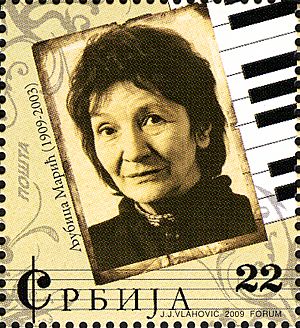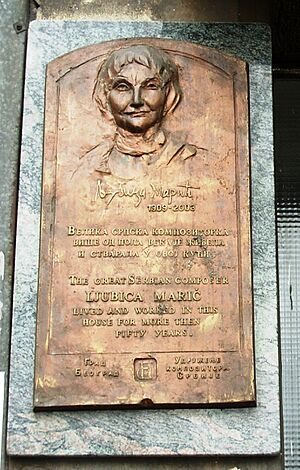Ljubica Marić facts for kids
Quick facts for kids
Ljubica Marić
|
|
|---|---|

Ljubica Marić on a 2009 Serbian stamp
|
|
| Born | 18 March 1909 |
| Died | 17 September 2003 (aged 94) |
| Occupation | Composer |
Ljubica Marić (pronounced LYOOB-eet-sah MA-rich; born March 18, 1909 – died September 17, 2003) was a famous composer from Yugoslavia. She was a student of Josip Štolcer-Slavenski. Ljubica Marić was known for being inspired by old Byzantine Orthodox church music.
She was also a professor at the Faculty of Music in Belgrade and a member of the Serbian Academy of Sciences and Arts. Many people think Ljubica Marić was the most original and important Serbian composer of the 1900s.
Contents
Early Life and Education
Ljubica Marić was born in Kragujevac, Serbia. Her father was Pavle and her mother was Katarina. Her family had a connection to Vojvoda Čolak-Anta Simeonović, who was a leader in the First Serbian Uprising.
Ljubica worked very hard to help Serbian music grow and become well-known. She was the first Serbian person to earn a diploma in composition in 1929. She continued her studies at the State Conservatory in Prague with Josef Suk. Even as a student, her music was praised at festivals in Amsterdam, Strasbourg, and Prague.
A Pioneer in Music
People described Ljubica as a very talented woman. Her music was supported by Hermann Scherchen, who was a big fan of new music. Important music groups and orchestras performed her works. She was even offered a job as a professor at the Prague State Conservatory.
However, World War II stopped her international career. So, she spent most of her life in Belgrade. There, she focused on writing more music. She also enjoyed visual arts and wrote philosophical poetry. She taught as a professor at the Belgrade Music Academy and became a member of the Serbian Academy of Arts and Sciences.
Her Unique Music Style
Ljubica Marić was the first composer to use Byzantine church music in pieces that were not for church services. She mixed old medieval music with new and experimental ideas from the 1900s. This helped her create music with deep, thoughtful lyrics.
Her music was so new that it hinted at future styles like postmodernism and minimalism. Some people even see her as someone who came before famous composers like Arvo Pärt and John Tavener.
Later Career and Recognition
Later in her life, Ljubica Marić's music became popular again in big European cities. These included places like the Netherlands, Germany, and Great Britain. In Amsterdam, a CD of her chamber music was released.
A group called KölnMusik asked her to write a new composition. A publishing company from Kassel printed the music scores for all her compositions. Also, a CD with her most important works was released by Chandos. Many people consider Ljubica Marić to be one of the most original artists from the second half of the 1900s.
Legacy
In 2009, Serbia asked UNESCO to celebrate the 100th anniversary of Ljubica Marić's birth.
Dmitry Shostakovich, another famous composer, said about her music: "Ljubica Marić used all the tools of modern music to reach a high goal. She speaks from the deepest part of her soul with clear and powerful language." Many other great artists of the 1900s also praised her music and its unique style. These included Bartok, Lutoslawski, Haba, Nicolas Slonimsky, Hermann Schrechen, and Marius Flothuis. They all believed that Ljubica Marić's compositions were among the greatest music creations of the 20th century.
List of Compositions
- Sorrow for the Girl, for men choir (1928)
- Sonata fantasia, for violin solo (1928/29)
- String quartet (1930/31) – lost
- Wind quintet (1931)
- Music for Orchestra (1932)
- Suite, for quartertone piano (1936/37) – lost
- Trio, for clarinet, trombone and double bass (1937) – lost
- Sketches, for piano (1944) – lost
- Four improvisations and fugue's on the themes of Octoëchos, for piano (around 1944) – lost
- Three Preludes and Etude, for piano (1945, rev. 1997)
- Two songs, for mixed choir (1945) – lost(Romanija, The Mist)
- Triumphal March, for symphony orchestra (probably 1945) – lost
- Three folk songs, for mixed choir (1946)
- Children's Choirs (1946/64)(Chicken's Worries, Nightingale and the Hunters, Enigmas, Violet's Shortcoming)
- Song and Dance, for piano (1947)
- Branko's Round Dance, for piano (1947)
- Sonata for violin and piano (1948)
- Verses from “The Mountain Wreath”, for baritone and piano (1951)
- Songs of Space, cantata for mixed choir and symphony orchestra (1956)
- Passacaglia, for symphony orchestra (1957)
- Octoïcha 1, for symphony orchestra (1958/9, rev.1998)
- Byzantine Concerto, for piano and orchestra (1959)
- The Threshold of Dream, cantata for soprano, mezzo-soprano, narrator and chamber orchestra (1961)
- Ostinato super thema Octoïcha, for piano, harp and string orchestra (1963)
- Lament, Pastoral and Hymn, for mixed choir and instrumental ensemble, from the
- music for the speaking oratorio Words of Light (1962/66)(redaction Mirjana Živković, 2009)
- The Enchantress, melodic recitation for soprano and piano (1964)
- Song for the Flute (1976)
- Invocation, for double bass and piano (1983, rev. 1998)
- Monodia Octoïcha, for cello solo (1984)
- From the Darkness Chanting, recitative cantata for mezzo-soprano and piano (1984)
- Asymptote, for violin and string orchestra (1986)
- The Wondrous Milligram, for flute and soprano (1992)
- Archaia, for string trio (1992)
- Archaia 2, for wind trio (1993, rev. 1998)
- Torso, for piano trio (1996, rev. 1998)
See also
 In Spanish: Ljubica Marić para niños
In Spanish: Ljubica Marić para niños


